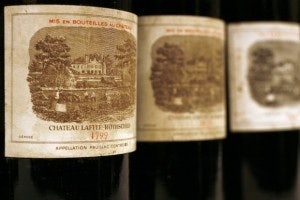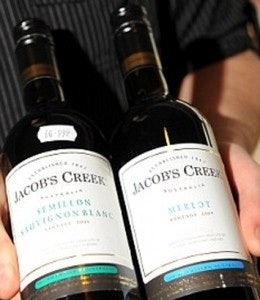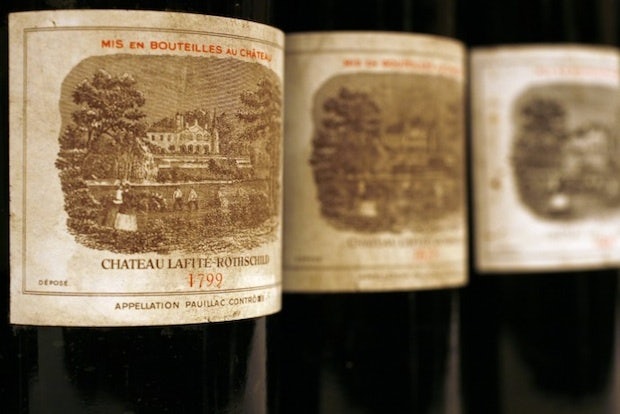Auction Buyers In Hong Kong Have Increasingly Turned To Burgundy#

Following a two-year tear that saw its prices at auction in Hong Kong skyrocket, over the past year demand in China for Château Lafite Rothschild has gone from a reflection of the country's booming luxury market to a reflection of the difficulties that plague major brands there. Though Chinese buyers continue to splash out for lots of top Bordeaux of particularly rare provenance, in the first quarter of 2012 prices for the likes of Lafite at auction in Hong Kong are down 20 percent from the market highs achieved in the middle of last year. At the same time, as Jing Daily first noticed in late spring of 2011, wealthy Chinese buyers have turned to a new darling, top-flight Burgundy Domaine de la Romanée-Conti. Perhaps no wine has been as hard-hit by this shift as Chateau Lafite. Its image damaged by its draw among brash nouveau riche drinkers in inland China, rampant counterfeiting and unsustainably high prices at auction, Lafite is no longer king in China's high-end wine market.
Lafite is out, and Conti is in, according to the last few major wine auctions in Hong Kong. That much was clear last year, when the Lafite market tanked at the November wine sales. The auction houses had gotten used to being almost 100 percent sold every sale, but in the fall of 2011 prices dropped precipitously and Christie's sold only 84 percent of the lots offered. Many of the failed cases were Lafite. The bright spots of those auctions, however, were wines from the Burgundy region of France as well as Italy.
Though Lafite has taken measures to fight the counterfeiting that has hurt its image and its bottom line in China -- among them installing a state-of-the-art Prooftag security system on bottles of Chateau Lafite Rothschild and Carruades de Lafite labelled since Feb 2012 -- bad press continues to come out in the Chinese media. Most recently, the Shenzhen Economic Daily (深圳商报) looked at reports of bottles of counterfeit Bordeaux, including Lafite, making buyers ill. Though this is of no fault of the winemakers themselves, the story indicates how counterfeiting of high-end food or beverage items can be damaging to a brand in China and, as such, reflects the urgency with which brands need to install special fake-fighting features and invest in marketing focusing on consumer education.
From the Shenzhen News (translation by Jing Daily team):
In a survey of readers, we received several complaints of developing acute gastroenteritis and diarrhea from drinking counterfeit imported wines. Yesterday, we received a report from one reader, "Mr. Xu," who recently had an embarrassing experience at a nightclub when celebrating with a friend who'd just returned from studying abroad in Europe.
On April 18, Xu and two other close acquaintances took his recently returned friend, "Mr. Yen," to a nightclub on Binhe Street in Shenzhen's Futian district. In all, the group enjoyed two bottles of [name not included] imported Bordeaux wine. Having experience in drinking wine abroad, Mr. Yan took charge of the wine selection. The group had a great reunion until 2 in the morning. Unexpectedly, Mr. Xu developed stomach pain and diarrhea after returning home and visited the hospital that morning. At Peking University Hospital in Shenzhen, Xu was administered an IV drip. Calling his friends to ask how they felt, Mr. Xu was told by Mr. Yen that they all had stomach problems as well.
Mr. Xu went back to the club in Futian district the following night to question them about the wine. However, the club assured him that all of their wines were legitimately imported. Since there was no solid evidence that his and his friends' illnesses were caused by the wine, they were not able to investigate further into the problem.
A similar episode happened to a "Mr. Xiong," who lives in Futian district. Xiong ordered an expensive bottle of red wine at a nightclub in Longhua, later experiencing gastrointestinal issues. Said Xiong, “Whether it's low-quality wine or fake imported wine, almost every club in Shenzhen sells it, and they have ways of getting around the laws.”
One Shenzhen bartender named Fan confirmed with us that many of the city's nightclubs serve so-called "imported" red wine, but in fact most of them are produced at small factories in Shenzhen. They're produced and bottled using low-quality materials, afterwards packaged with a fake foreign label.
Said Fan, “One of my friends works in the 'wine bottling' industry in Shenzhen, and they use the 3+1 method at their fake 'winery' – which is mixing food dye, MSG, alcohol and water. The food coloring they used contains Amaranth dye, which is apparently carcinogenic.”

According to Shenzhen Wine Association secretary-general, Jiang Zumao (蒋祖茂), "Although the imported wine market in Shenzhen is, on the surface, doing well, it's got many problems." Explained Jiang, several main issues continue to plague the city, including chaotic sales channels caused by an exploding number of inexperienced wine importers and vendors. Some of these importers, Jiang said, simply import empty wine bottles from overseas, filling them with cheap bulk wine and selling them to distributors and bars. This fits with recent reports of bottles of Chateau Lafite filled with low-quality plonk on offshore boats and sold within China by the Shanghai Daily. Until Chinese consumer palates develop to the point that they can identify obvious wine defects, Jiang said, counterfeits will continue to plague the industry -- and damage winery reputations -- for years to come.
